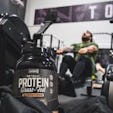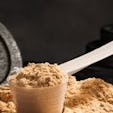Summary
– Creatine is a molecule found in animal foods that helps fuel muscle contractions. It has been shown to help users gain muscle and strength, and support performance in short duration, high-intensity activity.
– Whey protein is derived from cow’s milk. It is a fast-digesting protein that is rich in leucine, a BCAA that signals muscle protein synthesis. Whey can aid muscle growth and body composition.
– Creatine needs to build up in your muscles in order to be effective. Whey protein can be taken as needed to help you reach daily protein requirements.
– Neither creatine or whey protein is illegal or has been shown to be hazardous to health.
Creatine Vs. Whey Protein: What You Should Know
Creatine and whey protein are two of the most popular and effective sports supplements ever to hit the market. Both have been shown to help build muscle, but they’re two very different products that work in different ways. Price-wise, creatine is fairly cheap, while whey protein can be a big investment. So which one is appropriate for your goals and budget, and is it better to choose one over the other, or use both together?
We’ll examine both creatine and whey to help you determine the right muscle supp for you.
What Is Creatine?

Creatine monohydrate is a molecule that exists naturally in animal foods such as meat, eggs, and fish. However, you’d have to eat pounds of protein-rich food to get an efficacious dosage, which is why creatine is mainly discussed as a supplement.
Creatine plays an important role in fueling muscle contractions. The energy source for muscle is a molecule called adenosine triphosphate (ATP). When you lift, run, jump, or otherwise use your muscles, ATP loses a phosphate molecule and breaks down to a byproduct called ADP. For the muscles to keep working, they must regain a phosphate to transform ADP back into ATP, and that’s where creatine comes in.
Creatine monohydrate binds to a phosphate molecule to form creatine phosphate, which then restores ATP and your muscles’ ability to do work. In short, creatine supplies energy. It’s the main energy source for short duration, explosive, highly intense muscle contractions, such as those required in sprinting and weight training. (Creatine doesn’t do much for exercise that lasts more than a few continuous seconds. Stored carbohydrate, and then oxygen, fuel aerobic training, such as jogging and long-distance cycling.)
Supplementing with creatine allows you to do intense work for longer without fatiguing. In other words, it can help you to sprint a few more seconds at your top speed, get more jumps at your best height, and perform more reps with a heavy weight. This means that creatine helps you perform more overall volume in your workouts to get a greater training effect, and it’s one reason creatine has gained enormous popularity with bodybuilders and other athletes who rely on weight training.
Another reason muscle-seekers love creatine is that it helps draw water into the muscle cells. Muscles that are more hydrated will appear bigger, so some critics have accused creatine of only helping to create the illusion of larger muscles. But the fact is that hydrated muscles are better primed to grow.
Creatine has been popular since the early 1990s, and it’s come to be one of the most well-researched supplements out there. The International Journal of Sports Nutrition and Exercise Metabolism published a meta-analysis of 100 studies that concluded that creatine helps with body composition and resistance training performance, regardless of sex or training experience.
If you’re a gym rat looking to get stronger, creatine ought to be on your radar. A review of 22 studies determined that lifters taking creatine averaged eight percent greater strength gains than those on a placebo; they also saw an average 14% increase in reps performed at a given percentage of their one-rep max (the greatest amount of weight you can lift for one repetition on an exercise). Their bench press gains were especially impressive—one-rep maxes shot up as much as 43%.
If you’re wondering if creatine can help you in sports, the answer seems to be a resounding yes. A study on elite wrestlers found that creatine aided both average and peak power on an anaerobic endurance test. Another trial on elite soccer players showed that creatine takers sustained jumping power while a control group got fatigued. Meanwhile, a similar study on collegiate volleyball players found that creatine helped users maintain jump height.
As far as research goes, here’s the big kahuna on creatine to sum it all up: the Journal of the International Society of Sports Nutrition issued a position stand in which it declared that “creatine monohydrate is the most effective ergogenic nutritional supplement currently available to athletes in terms of increasing high-intensity exercise capacity and lean body mass.”
Read more in our creatine guide.
What Is Whey Protein?

Whey protein is a component of cow’s milk that was historically seen as a byproduct of cheese making. Farmers used to throw it away in favor of casein, the other protein in milk that can be processed into cheese. The nursery rhyme about Little Miss Muffet eating curds and whey refers to a dish of cottage cheese—casein protein being the cheese curds and whey the liquid that surrounds them.
Like other animal proteins, whey is complete, containing all the essential amino acids that your body can’t make on its own. This gives whey an advantage over plant-based protein supplements such as rice or hemp protein, which need to be combined with other protein sources to offer all the essential aminos the body needs.
But what really makes whey a rock star in the sports nutrition world is the amount of leucine it offers. Leucine is a branched-chain amino acid (BCAA), and research indicates it’s probably the most important amino for muscle growth, as it signals the body to activate protein synthesis. In its 2017 position stand on protein needs for exercise, the International Society of Sports Nutrition (ISSN) recommended that athletes aiming to maximize muscle gains eat protein-rich meals every three to four hours throughout the day (20–40 grams of protein per meal), with each meal consisting of between 0.7 and three grams leucine.
Whey protein is so packed with leucine that research shows it actually offers more of the stuff per gram than several other high-protein whole foods, such as eggs and milk—we’re talking two to 2.5 grams of leucine in a standard 25-gram scoop of whey. Whey tops casein protein (the other protein supplement derived from cow milk) and soy protein in terms of leucine content, and, as a study in the Journal of Applied Physiology showed, it stimulates muscle growth to a greater degree.
But whey protein isn’t just for getting big. A 2014 study found that when subjects consumed whey before sitting down to their largest meal of the day, it helped to control appetite and promoted favorable changes in body composition and waist circumference compared to soy protein. A 2017 meta-analysis of nine studies showed that whey not only helped overweight and obese people lose fat, it also aided in reducing markers of risk for cardiovascular disease.
Whey protein supplements are available in two basic forms. It can come as a concentrate or an isolate. Whey concentrate is 70–80% protein, with the remaining components being some milk sugar (lactose) and fat. Whey isolate is 90% or higher, and has had nearly all the sugar and fat filtered out. As for which one you should choose, it really comes down to preference. Isolate is the purer, leaner option, but it’s more expensive. If you have trouble digesting lactose and want to better control your calories, whey isolate may be the better choice, but concentrate will save you money. With that said, there is more research on the benefits of isolate than there is on concentrate supplements.
Read more in our whey protein guide.
When and How Much Protein and Creatine Should I Take?

Whey protein has been hyped for its ability to be digested and absorbed into the muscles quickly, supposedly jump-starting the recovery process and improving muscle gains, but the importance of timing your protein intake has been overstated. Whey is indeed a fast-digesting protein, but a review in the Journal of the ISSN determined that total daily protein intake trumps timing, so there’s no great rush to consume and assimilate the stuff as long as your body gets enough over the course of the day.
One exception, however, is if you’re an athlete who does some type of training more than once a day. If you’re an MMA fighter, for instance, who lifts weights in the morning and hits pads in the afternoon, you’d be wise to recharge your muscles as quickly as possible after the strength training session so they don’t get depleted further by the skill work. Wrestlers and tennis players, who may compete multiple times in a day, are in the same boat. A study in the Journal of Science and Medicine in Sport found that subjects taking hydrolyzed whey protein—a type of whey that’s been processed so it digests even faster—were fully recovered six hours later.
How much protein you need in a day depends on your age, size, goals, and activity level, but the ISSN suggests around one gram per pound of bodyweight daily for individuals who strength train—and even more if you’re dieting, so you can preserve muscle mass while in a calorie deficit that helps you lose fat. So, a 200-pound person who lifts and wants to slim down should start eating at least 200 grams of protein per day. This can be done entirely with whole foods, but it’s often not practical (think: lots of chicken breast, tuna, and eggs), so many opt for protein supplements to help hit their goal number of grams. Whey protein supps offer around 20 grams protein per serving, and can be mixed up and chugged down in minutes.
As for creatine, timing may be a bit more important than it is for protein. One study found that consuming it post-exercise promoted better body composition and strength gains than when it was taken pre-workout, and another trial showed that subjects made better gains in their arms when they took creatine after workouts. But there doesn’t appear to be a bad time to take creatine. Whatever time allows you to take it consistently enough to see benefit is the one to go with.
And consistency is important with creatine. While a whey protein supplement can be taken as needed to help you reach your protein goals, creatine needs to be taken regularly so it builds up in your muscles. The standard recommendation is to follow a minimum three-day loading period where you take 0.3 grams of creatine per kilogram of your bodyweight (example: 23 grams for a 170-pound man). Then, back off to a maintenance dose of three to five grams daily thereafter. However, skipping the loading phase and taking two to five grams per day from the get go has been shown to work fine too—it will just take longer to see the effects because your muscles aren’t yet fully saturated with creatine. (But it may be more convenient and palatable than guzzling multiple teaspoons of powder throughout the day.)
Bodybuilders used to mix creatine with grape juice in order to disguise the chalky flavor and ensure better uptake by the muscles. Research shows that your muscles might retain creatine better when it’s consumed along with a carbohydrate source, but most studies show that mixing it with plain water, or blending it into any other beverage you like, works just as well. “A 2017 study showed that loading creatine alone aided physical performance to the same extent as creatine loading with carbohydrate ingestion,” says Vince Kreipke, PhD, CISSN, a performance specialist and member of Onnit’s advisory board. “This held true in both laboratory and real-world applications.”
Can You Take Whey and Creatine Together?

Both creatine and whey protein are effective when taken by themselves, and there’s nothing wrong with combining them if you so choose. One study showed no adverse effects in doing so, but the subjects didn’t enjoy any additional benefits by combining the two either. Another trial had essentially the same findings, although it’s worth noting that both studies were done on men middle-aged and older.
Now for the big question: is it better to take whey protein or creatine?
The answer is really up to you. Containers of creatine are usually under $30 and can last you months, while tubs of whey protein can go for around $50 and, with regular use, will need to be replaced in only a few weeks—so creatine is the more budget-friendly choice. It’s also linked to more performance benefits, so, if you’re an athlete, or you’re looking for an edge in the gym, creatine may be the smarter choice.
On the other hand, people who train hard need a lot of protein, and many of them don’t get enough. If you have trouble making your protein requirement daily, whey will do a lot to get you there, and it’s a powerful tool for body recomposition. Of course, if you can afford both supplements and want to maximize your muscle and performance potential, take both.
“If you’re already meeting your protein goals with your diet,” says Kreipke, “I would go with creatine. It’s much harder to obtain from diet alone, especially if one is vegetarian or vegan [remember, creatine exists naturally in animal foods].” However, if you find you’re not making your protein quota regularly, Kreipke says to prioritize whey instead. “If you’re not giving yourself the proper amount of amino acids to recover, you’ll eventually have problems. And whey has more research than creatine does showing it can help you build muscle while you’re losing fat.”
Are These Supplements Illegal?

Neither creatine or whey protein has ever been illegal or deemed unsafe. One study showed that athletes who supplemented with creatine for 21 months while training intensely suffered no health problems.
If anything, creatine may help to preserve health. A trial in the Journal of Athletic Training indicated that DI college football players who used creatine had a lower incidence of cramping than those who didn’t take the supplement. In 2017, the ISSN declared that creatine may serve to protect the brain. The scientists wrote that “Given all the known benefits and favorable safety profile of creatine supplementation reported in the scientific and medical literature, it is the view of ISSN that government legislatures and sport organizations who restrict and/or discourage use of creatine may be placing athletes at greater risk—particularly in contact sports that have risk of head trauma and/or neurological injury.”
Whey protein is just as innocuous, assuming you don’t have an allergy to it. As with eating a lot of any type of protein, you may experience gas and other mild digestive issues from consuming large amounts of whey, but there should be little reason for concern if you follow label directions. Some critics have alleged that high intakes of protein can stress the kidneys, but a study in the American Journal of Kidney Diseases determined that people with healthy kidneys aren’t at any greater risk.
A 2016 study adds further support with findings that men who strength trained and followed a high-protein diet for six months suffered no ill effects to their blood lipids, liver, or kidney function. Also of note: following a high-protein diet increased the subjects’ calorie intake significantly, but they didn’t gain fat.

)





